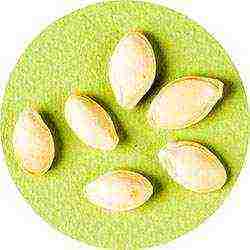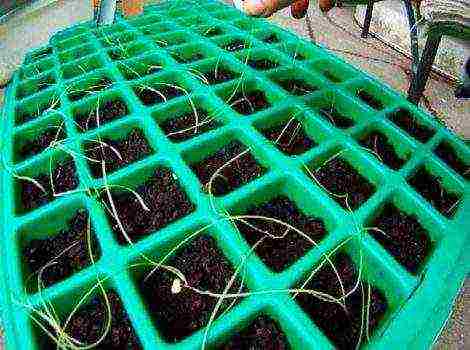Content [show]
Daffodils are unpretentious plants. They grow successfully in sunny and somewhat shaded areas. For their planting, lowered areas equipped with drainage ditches for the flow of flood waters can be used. Areas with stagnant water are unsuitable for them.
However, the unfavorable temperature distribution throughout the year is an obstacle to the successful cultivation of thermophilic plants such as daffodils. So, if the temperature conditions of autumn basically coincide with the biological requirements during the rooting of the bulbs, then their overwintering is not always favorable.
Daffodils are less demanding on the soil than tulips. They thrive on heavy and sandy soils, previously cultivated by adding sand, humus or plowing green fertilizers. 1.5-2 months before planting, the soil should be plowed to a depth of 25-30 cm. Loose nutritious soils can be cultivated no deeper than 20 cm.
The best fertilizer for daffodils is humus or compost (8-10 kg / m2). Plants also respond well to bone meal or phosphate rock (70-80 g / sq. M) and other mineral fertilizers applied, depending on the type of soil, in an amount of 30 to 60 g per 1 sq. M. m. When plowing, fertilizers are evenly distributed and embedded in the soil. Fresh manure for daffodils, as well as for tulips, is harmful. It can be applied no earlier than a year before planting.
Before planting the bulbs, the soil is plowed again to a depth of 18–20 cm and the plot is leveled. The bulbs are carefully examined and powdered with TMTD.
In the middle lane, they are planted in the soil in the second half of September to a depth of 8 to 25 cm, depending on size (the larger, the deeper), at a distance of 10-25 cm in a row.
The bulbs are planted in October so that they can take root well before the onset of stable frosts. In warm autumn, the roots of daffodils are formed in 20-25 days, that is, much faster than tulips. If you are late with planting daffodil bulbs, cover with humus or leaves with a layer of 8-10 cm. The shelter is carried out after slightly freezing the soil.
Planting depth depends on bulb size and soil type. It is believed that there should be a layer of soil above the bulb, twice its height. On average, this is about 12-15 cm. On light soils, the bulbs are planted deeper, on heavy soils - shallower.
With a row planting with a row spacing of 60-70 cm, the distance in a row between the bulbs of the first parsing is 10 cm, with a tape planting - 3-15 cm.
Caring for daffodils is almost the same as caring for tulips. During the growing season, from the beginning of the emergence of seedlings by loosening and weeding, the soil must be kept in a loose and weed-free state.
Daffodils can be successfully transplanted in the spring with a small damp clod of soil. Such plants bloom normally and form developed bulbs with a well-established branch bud.
In plants intended for growing planting material, branches are cut off, and in areas of landscaping, after the flowering of daffodils, ovaries are removed, since the ripening of the seed pods leads to the depletion of the bulbs.
Daffodils are watered no more than three times during the growing season and fed twice. The first time, when the sprouts reach a height of 5-6 cm, mineral fertilizers are applied in the aisles and embedded in the soil with subsequent loosening at the rate of 60 g / sq. m of ammonium nitrate and 30 g of granular superphosphate and potassium salt.
The second dressing is given during the budding period with the same mineral salts in a ratio of 1: 2: 1 or with a mullein solution diluted 30 times with the addition of 30 g of superphosphate and 15 g of potassium salt for every 10 liters of solution.
Before and after flowering, plants are sprayed with a 2% solution of TMTD.
The bulbs are dug out when the leaves are twisted and begin to dry out, which usually happens in central Russia in the first half of June.
Daffodils, monocotyledonous members of the amaryllid family, are distinguished by one of the earliest flowering, which contrasts against the background of just awakening nature. Flowers full of grace remind people of love and family comfort. And simple planting and caring for daffodils in the open field allows you to make them a decoration of every spring garden.
Daffodils: Planting Outdoors

Daffodils are unpretentious bulbous plants that appear in the garden after the snow melts. However, in order for them to delight the eye with their beauty and health, it is necessary to study all the nuances of planting.
When to plant?
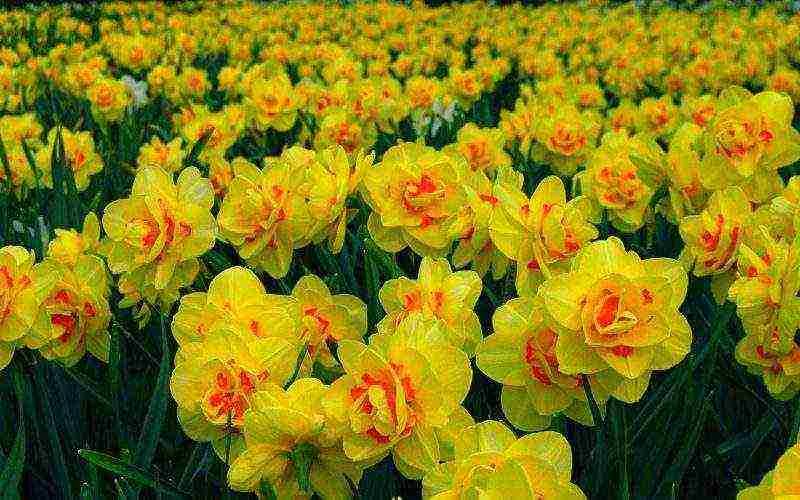
Planting dates, which are determined by soil temperature, depend on the climatic zone of a particular region. The optimal time is considered to be the period during which the soil temperature remains within 8-10 ° C for three weeks. As a rule, planting work falls on the autumn season, but spring sowing is also possible, taking into account the preliminary two-month aging of the bulbs in the refrigerator and the agro-climatic features of the site.
In outskirts of Moscow
Planting of daffodils in the fall in the suburbs is carried out from mid-August to mid-September, which is due to the achievement of the required temperature level of the soil during this period of time.
In the Urals

In this region, the planting of bulbs, conventionally called autumn, is carried out during August. On condition of warm autumn, the period can be extended until the first half of September.
In Siberia
In the Siberian region, planting of daffodils is carried out, as a rule, in the agricultural areas of the Middle strip.
Soil preparation and site selection
When carrying out a complex of planting works, the selection of a site, taking into account the soil composition, is of great importance: the future development of narcissists depends on the correctness of the choice. For healthy plant growth, a well-lit area with loose soil of a neutral reaction is suitable, where cereals, legumes and nightshade crops were cultivated before the planned planting of bulbs.
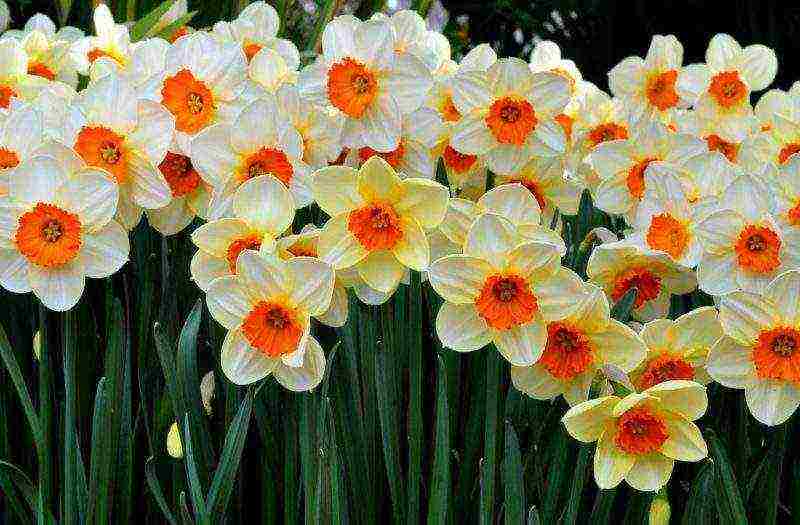
When preparing the soil to achieve the necessary indicators, the following fertilizers are applied:
- nitroammofoska - 60 g per 1m2;
- humus - 5 kg per 1 m;
- dolomite flour - 200 g per 1 m2 (with limestone soil);
- wood flour - a similar amount (with acidic soil).
The choice of planting material
Three months after the end of the flowering of daffodils, you can come to grips with the issue of acquiring planting material.
Before making a purchase, you should carefully inspect the bulbs for:
- the integrity and absence of diseased tissues;
- values - if the diameter of the bulb is less than 5 cm, then it will have to be grown, which will negatively affect the rate of germination.
- hardness.
How to plant?
When the temperature values of the soil reach the required level, it will be possible to start planting the bulbs, guided by the following algorithm of action:
- Injured, diseased bulbs are examined and discarded.
- Healthy planting material is placed in a pink manganese solution for decontamination.
- In the selected area, holes are prepared with a distance of 10 cm from each other if seating is planned, and 20 cm if natural growth occurs in the next five-year period.
- Sand is placed at the bottom of the holes for better soil drainage.
- On top are the bulbs, which are sprinkled with soil and covered with a 4 cm layer of mulch from sawdust or straw.
How deep should daffodils be planted?
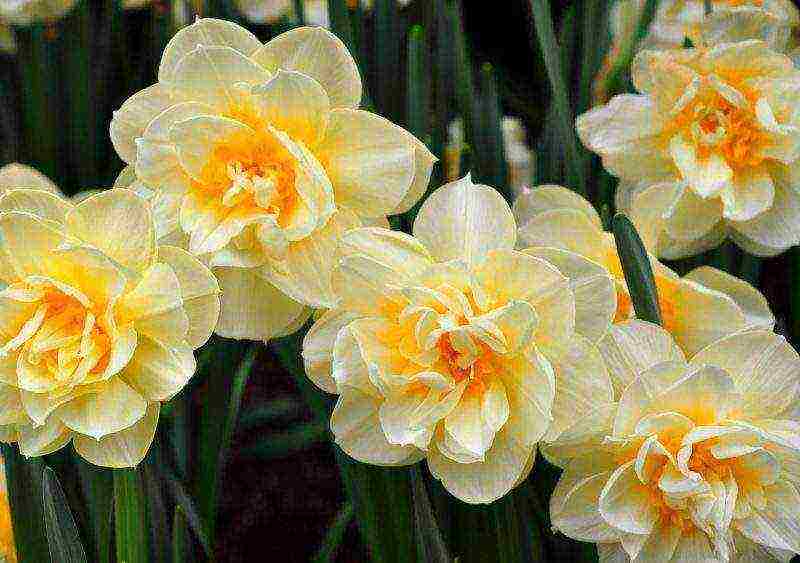
When preparing the holes, the florist is faced with the fact that the planting material has different analyzes, which means that the depth of the planting hole should be different. When calculating the parameter, it is necessary to take as a basis the triple diameter of the bulb: above the planting material after planting, the soil layer should be equal to two heights of the bulb.
Breeding methods in the open field
Growing daffodils is possible both from seeds and by separating daughter bulbs.
Vegetative way

During the period of active growth, from two to four are formed from one bulb, which, if desired, to obtain new plants, can be separated as follows:
- The bulbs are dug up and cleaned of plant debris.
- Sick, injured bulbs are discarded.
- The remaining bulbs are peeled off, washed under running water and placed in a pink manganese solution for 30 minutes.
- Then the stage-by-stage separation of the daughter bulbs is carried out - the first ones that fall off on their own are separated, then the tightly pressed bulbs swing.
- Divided bulbs are placed in a shaded area to dry. Then they are transferred to storage at a temperature not exceeding 17 ° C.
Advice! If the daughter bulb has come off, the place of the break should be sprinkled with crushed charcoal.
Seed method
Wild species without varietal characteristics that cannot be preserved with the generative method can be grown from seeds.

Wherein:
- Freshly harvested seeds are sown into the prepared holes and do not worry for the next 2 years, which makes it possible for the bulbs to gain strength.
- After the allotted time, new plants are transplanted to a permanent place.
- The first flowering of daffodils multiplied in this way is noted no earlier than 3 years later.
Important! In areas with harsh climates, forcing seedlings can be carried out in boxes.
Daffodil care
To enjoy the beautiful view of healthy flowers and inhale their exquisite scent, basic care must be followed.
Watering daffodils and loosening
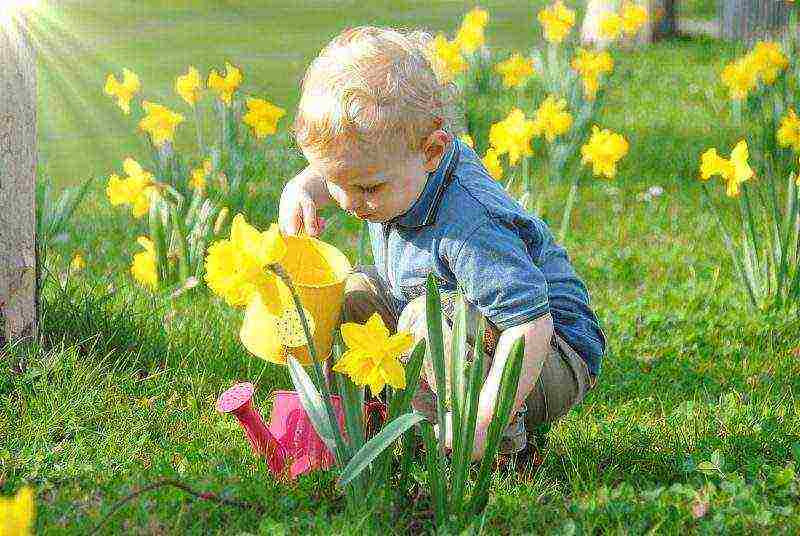
In conditions of little snowy winters and dry springs, plants need regular watering until the shoots are completely dry: moisture reserves activate metabolic processes in the bulb, which allows them to accumulate the required amount of nutrients. In the absence of a layer of mulch, after each portion of moistening, it is required to loosen the aisles.
Top dressing and fertilization
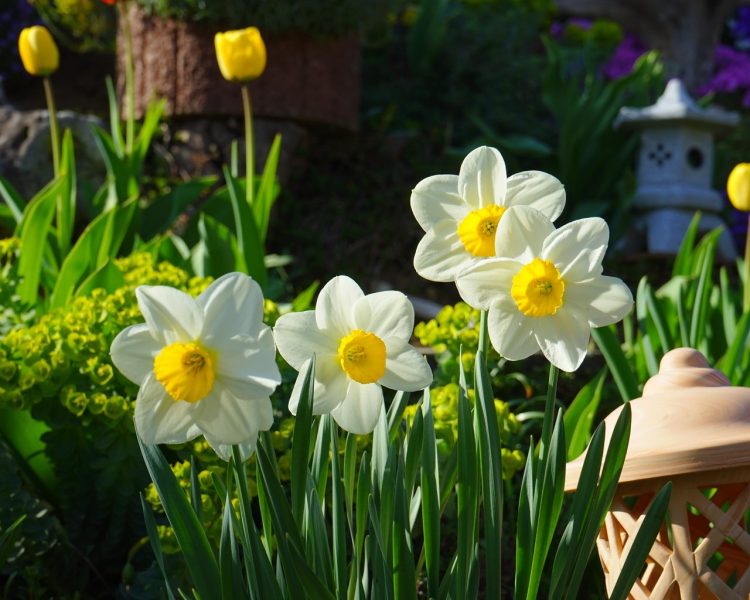
Growing daffodils in the open field provides for double feeding:
- During the formation of buds, the flowers are fed with a solution of complex mineral fertilizers with a consumption rate of 5 liters per 1 m2. A solution is prepared from 5 g of superphosphate, 10 g of potassium sulfate and 10 g of urea per bucket of water.
- During the flowering phase, a mineral complex for flowering plants with a similar consumption rate is introduced under the plants.
Advice! In the case of a sufficient amount of natural precipitation, it is worth using granular complex fertilizers.
Diseases, pests of daffodils and methods of dealing with them
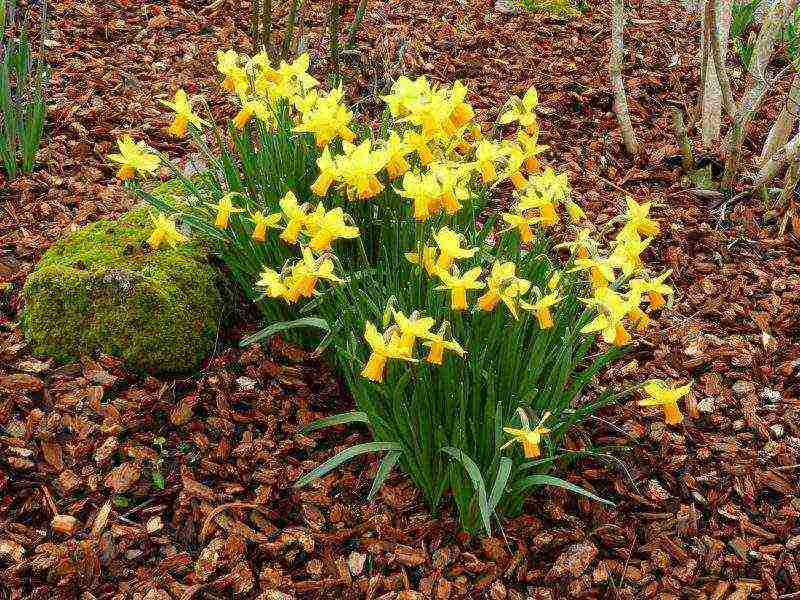
Spring flowers are prone to damage by harmful organisms. Among the diseases, fusarium and rot are distinguished, the protection from which is the pre-planting treatment of the bulbs. Of the pests on daffodils, the narcissus fly, tuberous and onion hoverflies, onion and root mites, slugs, nematodes are often noted, for the control of which a double treatment with insectoacaricidal preparations is used according to the manufacturer's instructions.
What to do after flowering?

If the florist plans to leave the bulbs to winter in the ground for further growth, then the following is done:
- After drying, the aerial part of the daffodil is cut off.
- The soil is loosened and cleaned of weeds.
- In August, in the absence of precipitation, the beds are watered several times.
- After the first frost, the plantings are mulched with a thick layer of compost or sawdust.
Digging and storing the bulbs
If transplantation or reproduction is planned, then the planting material is dug up and placed in storage.
Main steps:
- After the shoots have dried, the bulbs are dug up and cleaned.
- If necessary, the separation of children is carried out.
- The dried planting material is stored in a shaded, well-ventilated place.
How and when to transplant daffodils?
Transplanting a bulbous plant is required after 5 years of growth in one place. The procedure is carried out after the completion of flowering and drying of the aerial part in a natural way.
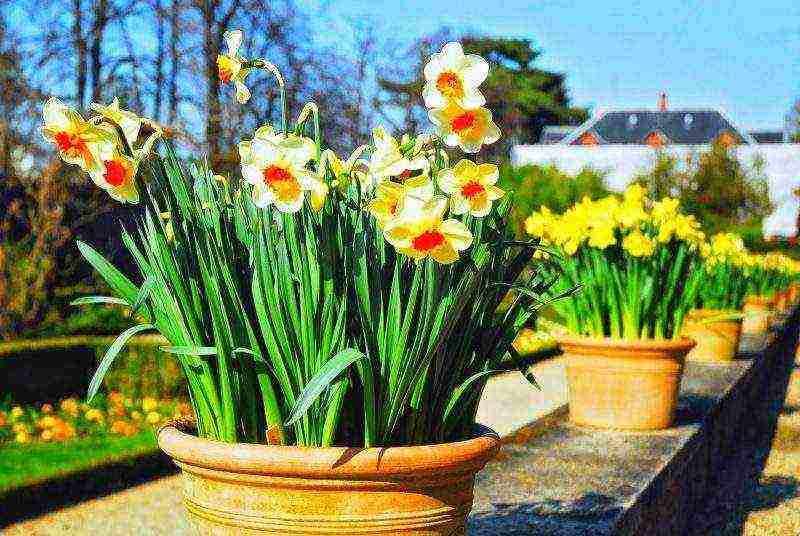
Wherein:
- The bulbs are removed from the soil, cleaned and sorted.
- Children are separated from healthy large bulbs.
- All planting material is dried, calibrated and stored in a dark room.
- Planting takes place in two months.
So, adherence to simple rules will allow you to decorate the spring garden with graceful, fragrant and very early flowers, which are rightfully considered a symbol of love and beauty.
“Whoever has two loaves, let him sell one to buy a daffodil flower, for bread is food for the body, and daffodil is food for the soul” - these are the words of Mohammed about this beautiful plant. Indeed, there are much more daffodils who love growing than those who are indifferent to them. It would be more correct to say - there are practically no such people. Daffodils, like tulips, are spring flowers, although not the first, but long-awaited. They are unpretentious in care, you just need to know and observe the nuances of growing.
Narcissus (Narcissus) is a perennial herb of the amaryllis family. The height of the bush is 25-50 cm. The root system is bulbous. The sheet plates are linear, assembled into a root rosette.
When the daffodil blooms
Daffodils bloom en masse in early to mid-May.
The flowering stem is leafless, flattened, rounded in cross-section. At its top is a curved peduncle (0.5-1.5 cm long) with a filmy wrapper, ending in a beautiful flower. Corolla bell-shaped, tubular or cupped, petal-shaped perianth.Flowers can be straight or drooping, are located singly (most often) or are collected in a racemose inflorescence of 2-8 pieces, simple or double. Basically, the colors are white or yellow, there are various shades of orange, two-tone.

Daffodils and tulips photo
The fruit is a fleshy tricuspid capsule filled with many seeds.
The genus has more than fifty primary species and about 60 hybrids. The poetic narcissus (Narcissus poeticus) is a type species.
There are more than 3000 varieties of daffodils, distributed mainly in southern Europe, the Mediterranean and Asia. Garden daffodils are the result of hybridization of different species.
The name of the plant comes from the Greek word "narkao", which means "stun", "intoxicate". This is due to the heady scent of flowers. The name of the type species (poeticus - poetic) is due to the fact that it is sung by poets of all ages and countries, like no other plant (not counting the rose).
Growing a daffodil from seed
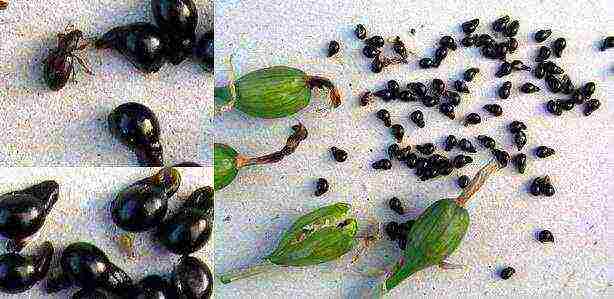
Narcissus seeds photo
- Use freshly harvested seeds for sowing.
- Seed collection is carried out in summer or late autumn.
- You can sow daffodil seeds in open ground before winter or in seedling boxes and grow in a greenhouse.
- The planting depth is 1-1.5 cm. Sow sparsely (approx. 10 cm distance) to provide sufficient space for the bulbs to develop.
- Grow indoors in a cool, dark place.
- A small onion will form after 2-3 years.
- During the growth period, it will be necessary to provide moderate watering and rare top dressing, 1-2 times in the spring season.
Reproduction of daffodil with baby bulbs
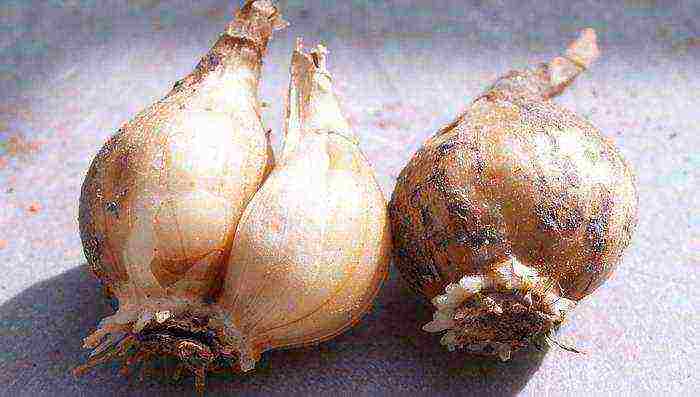
Daffodil bulbs with babies photo
Vegetative propagation is preferable - by daughter bulbs.
Depending on the level of agricultural technology and variety, an adult bulb forms 3-6 daughter bulbs in 2 years of growth in the ground. When the daffodils have faded and the leaf plates are partially yellow, proceed to dividing. Dig out a bush, carefully divide into separate bulbs. Plant large ones in a prepared area or send them for storage.
Daughter bulbs will need rearing. Make rows at a distance of about 20 cm from each other, moisten well, place the bulbs densely (6-8 cm) - they do not need much space. Sprinkle on top with a small layer of earth, water again.
Landing place
Daffodils feel most comfortable in open sunny areas, light shading is acceptable. Under the influence of direct sunlight, the flowers will be brighter, and in shade, the flowering is longer.
The soil requires a moisture-permeable, neutral reaction. Ordinary garden soil is perfect, and loam fertilized with humus or compost is also suitable. If the soil reaction is alkaline, add dolomite flour (200 g per 1 m²), acidic soil should be diluted with wood ash (1 glass per 1 m²).
It is better not to plant in a place where bulbous plants have recently grown, as well as perennial chrysanthemums, phloxes, asters. Planting is favorable after the growth of legumes, nightshades, cereals, cucumbers and peonies.
Planting and caring for a daffodil outdoors

How to plant daffodils in spring photo
When to plant daffodils outdoors
The most favorable autumn planting of daffodils in the ground, but spring planting is also allowed. In autumn they begin to plant from late September to late October, in spring - from early March to early May.
How to plant
- Dig up the area, make shallow holes, water well.
- Place 3-5 bulbs in one hole at a distance of 8-10 cm, of course, without mixing the varieties. Between different varieties, it is better to make a larger distance, since daffodils grow quite well - the bulbs can mix.
- The planting depth of daffodil bulbs is about 10-15 cm (the lighter and looser the soil, the deeper you can plant).
- Water well. Mulch with humus or rotted sawdust.
Planting in spring
In the spring, the depth of planting of daffodil bulbs is not difficult to determine: it is enough just to maintain the level of planting of the root collar, leaving it the same. It is better to cut the inflorescences right away so that the plants do not waste energy on flowering and gain enough strength for a successful wintering during the warm season.
When can you plant daffodils in spring?
This is best done before flowering, so the plants will have more opportunity to compensate for post-transplant stress and grow strong roots.
Can blooming daffodils be transplanted?
If you are planting flowers with buds, cut off the flower stalks. But do not disturb the flowers when they are already fading: the leaves will soon begin to fade, the bulbs will not have time to root properly.
Planting in autumn
The planting depth of daffodil bulbs is about 10-15 cm. It depends on how loose the ground is. In light soil, you can plant deeper: this way the bulbs will receive more moisture and will be better protected from winter frosts. In heavy soils, the planting depth is reduced. After planting, it is advisable to cover the flower bed with fallen leaves or mulch with humus.
Watering and loosening the soil
- Daffodils are quite hygrophilous. During the flowering period, water abundantly - the soil should be soaked to the depth of the bulbs, continue watering for 2-3 weeks after the end of flowering.
- After watering, loosen the soil, mulching the soil around the plant will save you from this maintenance procedure.
- Remove weeds from the area.
Pruning and feeding
Seed formation takes energy from the plant - cut off wilted inflorescences.
It is necessary to regularly feed with complex mineral fertilizers. Carry out the first feeding in early spring, but with low concentration. The second feeding falls on the budding period (focus on the dose of nitrogen and potassium), the third - during the flowering period (nitrogen, potassium, phosphorus), the fourth - after the end of flowering (apply potassium-phosphorus fertilizer).
Diseases and pests
Compliance with the rules of agricultural technology increases the plant's resistance to diseases and pests.
Occasionally, it is possible to be affected by fungal diseases:
- Fusarium - firstly, the bottom of the bulb is affected, climbing up the plant. The bulb becomes soft, covered with a bloom of a white-pink hue, the tips of the leaf plates turn yellow, then turn brown and dry out.
- Botrytis (gray rot) - a lush gray bloom with black dots appears under the covering leaves of the bulbs, the leaves are covered with light brown spots, the flowering stems and buds begin to rot.
- Penicillosis (penicillous rot) - prevents the bulbs from germinating in the spring. This happens due to high humidity.
Remove the affected areas, treat with a fungicide.
Possible infection with fungal diseases (mosaic, striping, ring spot, etc.). They manifest themselves with similar symptoms: spots, strokes, stains of different shades, oppressed flowering, the bulbs become smaller. Affected plants must be disposed of. To avoid troubles, take preventive measures, fight against insects that carry viruses (beetles, cicadas, whiteflies, nematodes).
For prophylaxis, before planting the bulbs for 30 minutes, it is necessary to hold Maxim in the solution. At the beginning of the growing season, spray the plants with Bordeaux liquid (concentration 1.5%).
As a prophylaxis against damage by a narcissus fly and a nematode, the bulbs are kept in hot water (43.5 ° C) for several hours before planting. During the budding period, spray the daffodils with a solution of Fitoverm (2 ml for 1 liter of water, consumption - 10 m²).
Use an appropriate insecticide when dealing with other pests.
Sometimes slugs can be found on the leaves of a plant - they are collected by hand.
Daffodil transplant
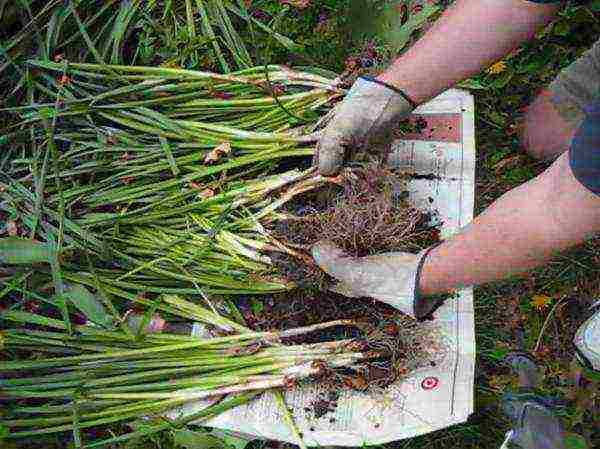
How to plant daffodils photo
In one place without a transplant, daffodils can grow up to 6 years.
The signal for transplanting is the deterioration of flowering.
However, experienced gardeners recommend replanting daffodils every 2, 3, or 4 years.In group plantings on the lawn, it can be kept for 5 years, while the bulbs are deeply buried in order to suppress the rapid formation of daughter bulbs. The most commonly used culture is 2-3 years old. To grow daffodils for cutting, it is advisable to replant annually.
What is a transplant? After the end of flowering, the bulbs must be dug up and sent for storage until planting (it is carried out at the end of next summer or early autumn). Some growers do not want to fool around and plant the bulbs right away, but remember: it is better to do this then in the spring, so that by autumn the bulbs will take root well and make a supply of nutrients.
Digging and storing bulbs
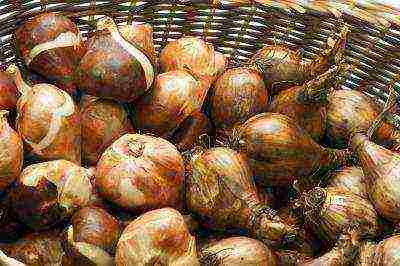
How to store daffodil bulbs photo
- The bulbs are dug out after flowering, when the leaves turn yellow and begin to separate.
- Dig up the bulbs, shake off the soil and dry them (store for 2-3 weeks in a well-ventilated place without access to sunlight, the air temperature should be 22-24 ° C).
- Then they carry out cleaning (remove dry, loose scales) and dividing the nests (proceed carefully so as not to touch the bottom).
- Discard diseased bulbs.
- Treat the rest with a solution of potassium permanganate (hold for 30 minutes, then dry), then place in a box or box.
- For the first 15-20 days, keep at an air temperature of about 17 ° C, then lower to 12-14 ° C and maintain at this level until planting.
Wintering
In temperate climates, daffodils successfully winter in open ground without shelter. If a severe snowless winter is foreseen, in late autumn, cover the soil with peat, cover it with spruce branches on top. The shelter is removed after the snow melts in the spring.
Types and varieties of daffodils with photos and names
According to the international classification, there are 12 groups of daffodils.
Trumpet daffodils

Narcissus tubular variety Dutch master photo
They have a long crown in the form of a tube, which is equal to or exceeds the length of the petals.
Pay attention to the Mount Hood variety.
Large-cupped

Narcissus large-crowned photo
Tubular or funnel-shaped crown, 1/3 longer than the length of the petals.
Notable varieties: Spring Pride, Daydream, Professor Einstein.
Small-cupped

Narcissus small-crowned photo
On the contrary, the length of the crown is 1/3 shorter than the petals.
For example, the Verger varieties.
Triandrus (Triandrus)

Narcissus triandrus photo
Flowers are collected in umbellate inflorescences of 2-4 pcs.
Varieties: Thalia, Hawera, Ice Wings.
Terry (Double)

Daffodil terry variety Narcissus Tahiti photo
Includes all double-flowered varieties.
Sorts: Rosy Cloud, Petit Four, Gay Chellenger, Pink Paradise, Yellow Cheerfullness, Rosy Cloud, Gay Kybo, Yellow Cheerfulness, Irene Copeland, Texas, Rip Van Winkle, White Lion.
Cyclamineus

Narcissus cyclamen variety Narcissus February Gold photo
The crown is long, the petals are strongly bent back.
For example, February Gold.
Jonquilla
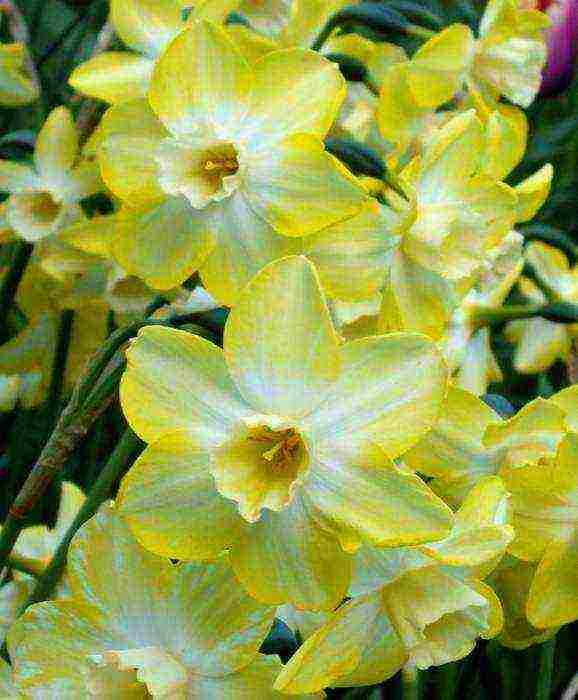
Jonquil's daffodil cultivar Narcissus Pipit photo
Flowers are small, on one peduncle there are 2-3 pcs.
Pipit cultivar.
Tazetta (Tazetta)

Daffodil Narcissus Scarlet Gem photo
Corollas are medium in size, one inflorescence can contain about 12 pieces.
Scarlet Gem is notable.
Poetic (Poeticus)
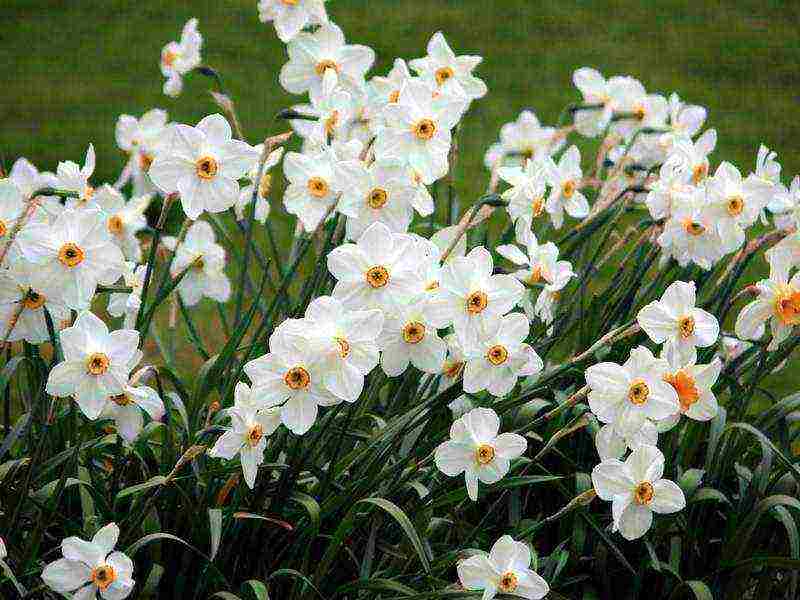
Poetic daffodils photo
Single flowers with a short crown, snow-white.
Split-Corona
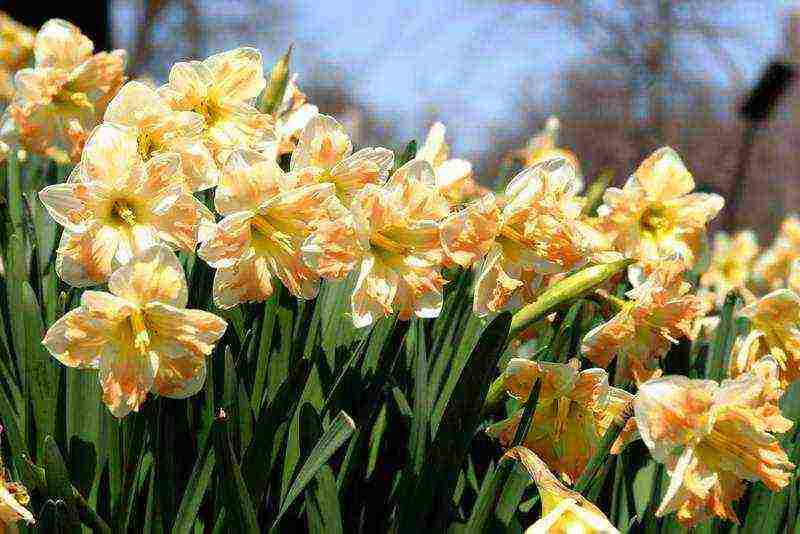
Crowned daffodil photo
The crown is divided into lobes.
Others
They have different characteristics inherent in different previous groups.
Daffodils in landscape design

Daffodils in landscape design photo
These spring flowers are used for landscaping flower beds, a rabatok, planted between shrubs, separate spots to decorate the lawn.
They are great in group plantings: small lawns look very natural.

Daffodils in a flowerbed with tulips photo
As for neighbors, do not plant nearby crops that will compete with daffodils for moisture and nutrients (crops with powerful, deeply penetrating roots).

Daffodils in a flowerbed with hyacinths photo
Plants with a superficial root system are suitable - tiarella, stonecrop, styloid phlox, etc. They will not interfere with the development of daffodils, and will also advantageously cover leaves that turn yellow after flowering.
The Legend of the Narcissus
An ancient Greek myth tells of a beautiful young man named Narcissus. He heartlessly rejected the love of the nymph Echo. For the coldness he was punished by Aphrodite: she made him fall in love with his own reflection in the water surface. From love to himself, he melted before our eyes, and in the place of a lifeless body this amazingly beautiful flower grew.
Since then, the word "narcissist" has become a household word, meaning narcissism and selfishness.
Narcissus is a flower, belongs to the amarilla species. It can please with beautiful flowering for more than one year. Loves light and open areas. Nature has endowed the daffodil with a beautiful inflorescence with a pleasant aroma. At the top of the dense stem, there are six white petals, inside which, in the form of a bowl, there is a yellow center. It is framed in orange, red and gold shades. Leaves are straight, elongated, grow from the roots of the plant and appear before the buds. The daffodil has a bulbous root system. New bulbs are replacing the old ones. The head of the inflorescence is straight or slightly inclined, as if drooping. One or more flowers can be found on the stem. Fruits with round seeds in the form of a triangular capsule.
Narcissus blooms in spring - in April, May.
It mainly grows in the garden, but it has also taken root in home pots on windowsills.

Types and features
All varieties of daffodils were combined into 13 groups. There are about 60 species in nature, bred by humans, there are 25 varieties. The most popular ones are:
- Tubular have one large inflorescence, color is white or yellow, there are two colors. The bulb is about 5 cm, not whimsical for reproduction.
- The large-crowned ones are famous for their variety of flowers. There is a single flower on the stem, the crown of which is one third of the size of the petals. The bulb is not very large.
- Small-crowned, mainly with a white-cream shade and a mild aroma, flowers are medium with a reddish crown. This species blooms later than others.
- Terry - one of the most beautiful species, there are one or more double flowers on the peduncle. The color is varied as well as the size. There are more petals than common daffodils, and the center is not bell-shaped.
- Triandrus is a plant with a low stem at the end of which there are two inflorescences. White bent petals are extremely beautiful and delight with long flowering.
- Cyclamen-like with early flowering, one flower on the stem, which has an apricot crown inside, which is longer than the yellow petals.
- Jonquililliae - this species blooms late. The golden center of the flower is much smaller than the yellow petals. It can grow for 7 years without a transplant.
- Multiflorous - daffodils of this species easily endure winter. Up to 20 flowers can grow on the stem. Small orange crown, flowers with a pleasant smell.
- White daffodil belongs to the Poetic species. He is the only one on the stem, survives the winter and is not afraid of the shade. This white flower has a green eye and a small bulb.
- Split-crowned - petals with a fringe and a cut crown like a moth.
Wild flowers come in a wide variety of colors and grow in the wild.
Features of growing in the suburbs
The unpretentiousness of these plants makes it possible to plant them in different places. They grow in open, sunny areas or in the shade. Cannot be planted in swampy areas, but tolerates sandy soils. A couple of months before planting daffodils, the soil needs to be plowed to about a depth of 30 cm.
Daffodils will bloom poorly if they are planted in places where bulbous plants grew.
Processed bulbs are planted in September. Some are planted as early as October, they should take root before frost.
Like tulips, daffodils need weeding and weeding.
The transplant can be carried out in the spring, pre-cut the stems so that the ovary does not deplete the young shoots. When the leaves are dry, the plants need to be dug up, cleaned and stored in a dry and ventilated area.If everything is ready for transplanting, then you can immediately move from one site to another.
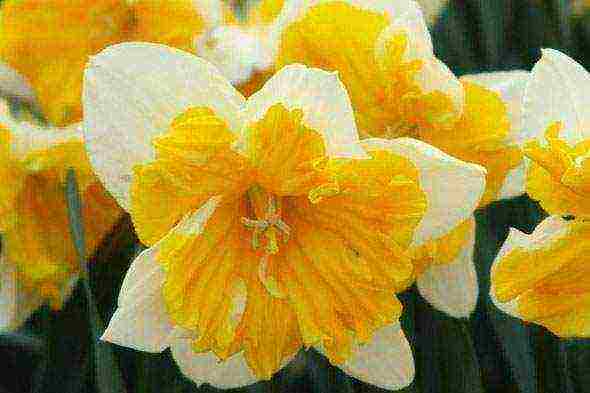
Daffodils are planted in the Moscow region from mid-August to mid-September. During this period, the climate is most favorable.
Planting material
In the store, carefully check the bulbs you like. They shouldn't be soft or weak. Such material may not germinate. It is advisable to buy when flowering lasts at least three months.
Don't buy daffodil planting stock in spring! It is better to buy bulbs in the fall before the onset of cold weather.
Bulbs must not be sprouted or blooming. It is not worth buying if one is large in the package and the rest are small. To make the garden delight you until autumn, it is better to choose several varieties of daffodils.
Popular varieties for the Moscow region
- The false or yellow daffodil is native to France and Germany. The stems are not high, about 30 cm. There is only one flower on the stem, the petals and calyx of which are bright yellow. Blooms in May. Looks noble on plots near houses along with tulips.
- Flowers of the White Daffodil were brought from the Iberian Islands. It is a mountain flower and is pure white in color. It also grows in pine forests. Leg 35 cm. Bulbs in the form of a ball. Blooms in May for about 10 days.
- The delicate beauty of Pink Narcissus will attract any attention. He comes from Italy. High stem (45 cm) with one flower, leaves are wide and dark. The pink bell inside the white petals gives off a pleasant scent. Blooms in May and surprises everyone around.
- The Tet-a-Tet variety amazes with its unusual flower shape. A short plant with one drooping flower. It is yellow in color, the petals are curved back, inside there is a long middle. Blossoms in May, planted along the roads.
- Terry loves moisture, they were brought from America. Long stem with several flowers on it. Terry petals in appearance.
- Daffodils of the Gay Challenger variety are low plants with one inflorescence. The orange crown looks like a hexagonal star with white petals around it. They serve as the highlight of any bouquet. Gives color in late spring.
- Texas is a terry flower. Various colors: white, yellow and pink. Brought from Germany. There is no cup inside, instead of it there are yellow petals. Unusual for his brothers.
- Ice King's inflorescence is large, lemon-colored, with a crown in the form of a peony inside snow-white petals.
- Tahiti is unlike more than one variety of daffodils. Instead of the usual bell, yellow-orange petals. Single flower.
- Rip Van Winkle looks more like a peony, the fluffy center is confusing: is it a daffodil? Loves moisture, small stem.
- Obdam daffodils are very delicate with a beige tint and spread a heady aroma. There are many petals in the middle.
Planting in the ground and caring for plants
Daffodils can be planted both in spring and autumn.
Selected bulbs without visible damage must be treated with a solution of potassium permanganate in order to prevent infection. The disembarkation begins after the ground has been plowed up and the holes have been made. The soil should be fertilized, preferably with humus or compost. If the soil is alkaline, add dolomite flour (200 g per square meter), wood ash is useful for an acidic environment (1 glass per square meter).
Bone meal and other fertilizers saturated with minerals are applied taking into account the properties of the soil. Manure can harm daffodils.
In addition to fertilizers, clay and sand are added to the soil. After being planted, sawdust and straw are added. This will help control weeds.
Large bulbs are carefully placed in the ground 15 cm. Between them 20 cm, this will prolong the longevity of the plant. It is enough to feed the flowers only 2 times:
- when the stems are 5 cm, add minerals;
- when the buds appear, they are fed with a mullein solution with superphosphate additives (30 g per 10 l).
Large amounts of nitrogen can leave plants without flowers.
Water it regularly, especially when the ground is dry. Many people irrigate with a hose, but this can ruin the flowers. The water temperature should be at room temperature.
In case of heavy rainfall, it is better to cover the daffodils so that the roots do not rot.
In autumn, peat (5 kg per 1 square meter) is added to the soil together with compost, superphosphates are needed for flowering. Dig up again and leave for a while.
You can plant bulbs in places where cereals grew, but not bulbs. Daffodils coexist well with tulips.
Withered buds take energy from blooming flowers, dead flowers removed in time will save the rest. If the inflorescences become smaller, you need to think about transplanting them, the new bulbs take all the necessary substances.
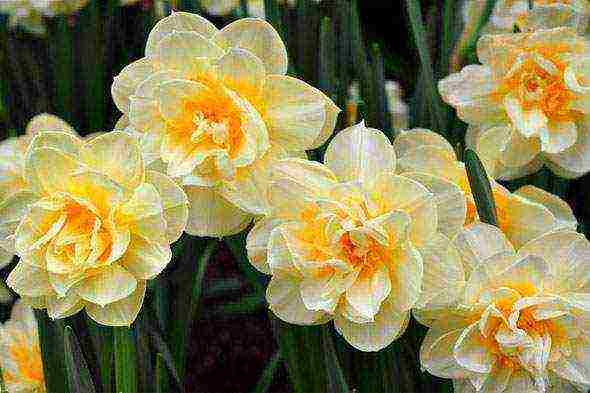
One bulb produces about four new ones per season. Old dry scales must be removed. It is necessary to separate the bulbs very carefully so as not to damage, if nevertheless it was not done carefully, treat the damaged areas with ash. Dry them in a warm place at least 18 degrees. Spread out so that each one lies separately. When stored for a long time, they lose moisture and may die.
Pests and diseases
If you properly care for daffodils, flowers will delight for more than one year. However, it should be borne in mind that they are susceptible to certain diseases:
- Fusarium infects the root system and moves along the stem. White bloom and lethargy are a vivid confirmation of this. The leaves dry up. Such plants must be removed so that neighboring flowers do not become infected.
- A terrible disease caused by gray rot is called botrytis. Gray mold with black specks infects the leaves and kills the plant.
- It happens that some of the bulbs did not sprout. Perhaps they were affected by a fungus. This disease is accompanied by a lot of moisture. For prophylaxis, before planting, the bulbs should be placed for a short time in Maxim's solution. Spray the sprouts with Bordeaux solution.
Viruses are merciless not only to humans, but also to plants. Various stains, spots, growth retardation or lack thereof, speaks of a disease in daffodils. Infection occurs through soil, seeds and water. Viruses don't give plants a chance. They are carried by flies, beetles, ticks and whiteflies. Disinfection will protect flowers from disease.
Wintering
Daffodils tolerate winter well. If the disembarkation was late, they could not root well. In winter, there are harsh days and the bulbs can freeze. Deceptive thaws can wake up plants, and after the next frost they will freeze.
With the onset of cold weather, the flowers must be covered. You need to cover plants with large inflorescences. Dry grass, foliage, nut shells will do. Everything must be cleaned up in the spring.
